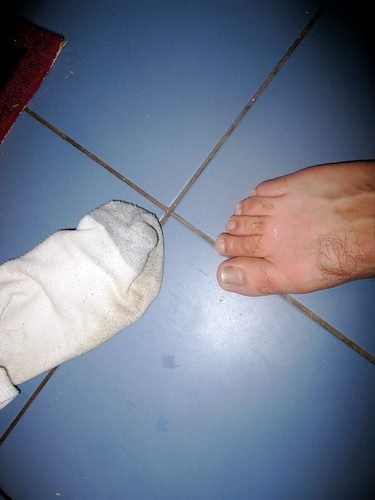My Burnt Foot
Picture it: my kitchen, last Thursday. I'm standing at the stove attempting to make Colman Andrews' recipe for Rigatoni with Chickpeas and Anchovies from Nancy Silverton's "A Twist of the Wrist" and I have a giant vat of water boiling for the pasta. The sauce is simple: you just take 12 anchovies, mash them up with salt, and then add one chopped up celery stalk and the liquid from a can of chickpeas. Only after opening the can and pouring the liquid in do I realize that somehow, quite strangely, I'd purchased kidney beans--even though I recall staring at a shelf of chickpeas at the store--and now the sauce is ruined.
Luckily, I have chickpeas in my cabinet (I'd forgotten I had them) and 12 more anchovies and another celery stalk so I start the process over from scratch. I mash the anchovies with salt, I add the celery and the chickpea liquid and then, when the water's boiling, I add salt and half a box of rigatoni to the pot.
For the past 365 days, I'd been using Diana's pot to make pasta. It's the perfect size: big enough to let the pasta move around, small enough to maneuver easily. But when she moved out she took the pot with her. So all I have now is a small pot, too small for good pasta, and a giant stock pot. That's what I'm using this night: the giant stock pot. It's enormous, towering on the back of my stove, shaking with activity as the pasta cooks.
Here's where I'm an idiot. Colman Andrews says to drain the pasta in the sink and to add the pasta back to the pot to toss with the anchovies, chickpea water, chickpeas, and Parmesan cheese. I like the idea of tossing all this around in the empty pot: the residual heat will cook everything a bit, bring it all together.
So I place a strainer in the sink and when the pasta's done I lift my giant stock pot off the stove and move it to the sink. I tilt it away from me, so the boiling water tips out ino the sink, only the pot is so heavy that the motion causes me to lose my grip a bit and I proceed to pour scalding hot water--bubbling, bursting, brusing water--all over my foot.
My sock soaks up with the heat and I don't even yell out. I do a sharp intake of breath and put the pot on the floor as I pull off my sock. Then I hop around and yelp: "Ow! Ow! Ow!"
I go to the couch and stare at my foot and there's not much to see. But it burns like Anne Coulter's vision for my life after death; and a few days later it looks like this. [WARNING: Do NOT show this picture to small children, bunnies, kittens, or anything else sweet and innocent and in danger of corruption--it will destroy their faith in humanity.] I am proud to say: this is my worst kitchen injury. Isn't it cool?
But you must be wondering: how was the pasta? Was it worth it? Well this is what it looked like in the pot when I was ready to mix it all together, like Colman suggested:

And here's the finished bowl, garnished with celery leaves:

What did I think? Was it worth all the stress? Do I need a podiatrist and/or a pedicurist? The answer: it was ok. I didn't love it, but granted this pasta would have to be pretty fantastic to overcome the emotional strife it caused me. I liked the loud presence of the anchovies, but I longed for the garlic that would've made this "dressing" more Caesar-like. If I did it again, I'd have mashed up garlic with anchovies at the beginning.
But chances are, I won't be doing this again: I'm suffering from Post Traumatic Pasta Disorder. Maybe, after years of therapy, I'll be ready to make pasta again. If you see me cooking in rubber boots from now on, though, you'll understand why.

